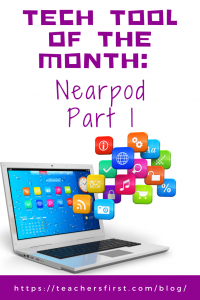Nearpod is a device-agnostic tool for creating interactive presentations and assessments. Teachers can also use one of the pre-made presentations from an extensive library that includes both lessons and videos. When creating your own presentation (or editing an already-created lesson), you can add images, audio clips, PDF files, videos, multiple-choice questions, polls, and more. There are other options such as Draw It (when students can write directly on a slide), open-ended questions, and other extras. Teachers have the option to make the presentations/videos self-paced for students or have live participation as a lesson guided by the teacher. Teachers can also launch a lesson with Zoom video conferencing during a remote learning lesson with just one click! This is a versatile tool for distance learning, blended learning, and traditional learning in the classroom.
Applying the Triple E Framework
The Triple E Framework, created by Dr. Liz Kolb, is built on the belief that “effective technology integration begins with good instructional strategies and not fancy tools” (tripleeframework.com). Dr. Kolb wrote a book on the topic, Learning First, Technology Second (ISTE, 2017), that lays out the three main uses for technology in education: to Engage, Enhance, or Extend learning goals. We can use this framework to decipher why we are using specific tools in the classroom. Here is a rubric based on the Triple E Framework you can use to evaluate whether Nearpod (or any other technology) is a good fit with your learning goals and whether you should use Nearpod in your lesson.
- Engage in learning goals: When using Nearpod, students can focus on the activities with fewer distractions so there is more time on task. Nearpod helps motivate students to begin the learning process, as the material is presented in an organized and not distracting manner. Students also take on the role of active learners by engaging in the lessons, questions, polls, videos, and other features instead of passively observing.
- Enhance learning goals: This tool enhances learning goals by allowing students to demonstrate a more sophisticated understanding of the content through answering questions, polls, or even drawing a response. This demonstrates understanding deeper than just reading the text. Nearpod also offers the options to scaffold the information for differentiation. This is especially true if students are doing a Nearpod lesson in the self-paced format, as they can work at their own pace and even re-watch videos or re-read content before moving on to the next part of the assignment. The lesson activities are not isolated in workbooks or stand-alone, but are rather connected and weaved throughout the Nearpod lesson.
- Extend learning goals: Dr. Kolb describes extended learning as an opportunity for students to learn, connect, and collaborate outside of the regular school day and as a bridge between the school day and real-life experiences. Nearpod would fit in with flipped, blended, and remote learning lessons. If students complete a Nearpod lesson in the self-paced mode, they can learn outside of the regular school day (or the walls of the school building). The technology also helps students practice skills they will use in the future, as many classes and careers will require students to use technology and to work through various steps of lessons or projects until completion.
SAMR Connection
The SAMR Model, by Dr. Ruben Puentedura, suggests that technology implementation has four levels. We can use this model as a guideline to analyze how we’re using technology tools in the classroom. Depending on how you are using Nearpod, this tool could be used at every level of SAMR.
- Substitution: At this level, technology replaces a traditional classroom assignment with little to no significant improvement or changes. Nearpod could be at this level if the teacher uses Nearpod as a different way to show PowerPoint slides (with few or no activities added) to the entire class during a live lesson. A teacher could also do something simple, such as upload a PDF or other document to share.
- Augmentation: At this level, technology acts as a direct substitute for a tool but also provides functional improvements. Nearpod could be used at this level if teachers add simple “extras” to the presentation, such as polls or quick quiz questions. These features of a presentation could not be done without technology and offer additional ways to engage students using the technology.
- Modification: The level of Modification allows us to make (or modify) the activity into something more integrated with technology, meaning there is significant task redesign. Many functions of Nearpod, like the drawing option, would not be conceivable without technology. Including videos, VR activities, links to other web resources, and collaboration would also not be possible without the technology Nearpod offers.
- Redefinition: At this level, technology is used for a learning task that would not be possible without the technology. The personalized learning offered by Nearpod takes this tool to the level of redefinition. Teachers have the option to deliver lessons to small groups or individuals by using the self-paced options. This allows learning and assessment to continue at any time. Nearpod achieves this level in live presentations as well, as the teacher has the presenter controls and can push out the presentation and assessments to students and progress to the next activity when complete.
Don’t miss Part 2 of the Tech Tool of the Month: Nearpod, where we’ll discuss how to use the tool and introduce ways to use it in the classroom. In the meantime, let us know in the comment section below how you have used Nearpod in your education setting.



Thank you so much for your introduction of Nearpod, it is such a powerful tool which inspired me to try it on in my final project of a Master degree course in creative technology. I created a formative assessment to check if students can capture the essential idea from a text. I also integrated a visible thinking routine: Color, Symbol, and Image into my assignment.